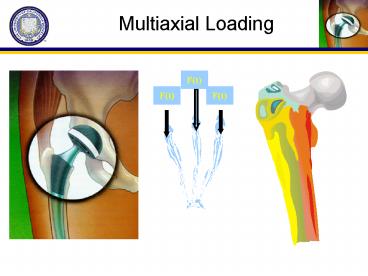Multiaxial Loading - PowerPoint PPT Presentation
1 / 14
Title:
Multiaxial Loading
Description:
Multiaxial Loading. F(t) F(t) F(t) How do we relate stress and strain? Isotropy vs. Anisotropy ... Assume that this device is loaded with a compressive stress ... – PowerPoint PPT presentation
Number of Views:74
Avg rating:3.0/5.0
Title: Multiaxial Loading
1
Multiaxial Loading
2
How do we relate stress and strain?
3
Isotropy vs. Anisotropy
4
Multiaxial Hookes Law
- ?????x 1/E?xx - ?? ?yy ?zz )
- ?????y 1/E?yy - ?? ?xx ?zz )
- ?????z 1/E?zz - ?? ?yy ?xx )
- ?????xy ?xy/G
- ?????xz ?xz/G
- ?????yz ?yz/G
5
Example Multiaxial Loading in a glenoid component
- Consider the glenoid component of a shoulder
implant that is subjected to axial loading
(z-direction) but is confined against deformation
in both the x and y directions. - Assume that this device is loaded with a
compressive stress ?zz 30 MPa. The bearing
material is UHMWPE. Assume that the material is
linear elastic and isotropic. The material
properties are as follows E 1 GPa, ?yield 25
MPa, ? 0.4. - What stresses develop in the device?
6
Analysis
Strains in x and y directions are zero due to
constraint. Substitution leads to
20 MPa
7
Rule of Mixtures Bioactive glass coating
- A polymer sleeve with a bioactive glass coating
is designed with an internal diameter equal to
6-mm and an outer diameter equal to 12-mm. - This type of device can be used to help with bone
in-growth for a joint replacement. It is often
desirable to design these sleeves to have a
modulus similar to that of bone. - We can use the rule-of-mixtures to design the
composite cross-section, of only the polymer and
bioactive glass, such that the axial modulus of
this sleeve is equal to that of cortical bone.
8
- A schematic of the cross-section is shown below.
Assume the following material properties - E-polymer 10 GPaE-bioactive glass 27
GPaE-cortical bone 17 GPa
bioactive glass
polymer
6 mm
12 mm
9
Analysis
- For this problem, the upper bound of modulus for
the rule-of-mixtures can be assumed. The equation
is given below
EEQUIV the equivalent modulus, you want this to
equal 17 GPa Apoly cross-sectional area of the
polymer Aglass cross-sectional area of the
bioactive glass The cross-sectional areas of the
polymer and bioactive glass are unknown.
10
Analysis cont.
- t thickness of the polymer (this is what you
need to solve for) - ri inner radius of the cross section 3mm, ro
outer radius 6mm. Solve for t and simplify
it to get a quadratic equation
t tpolymer 2mm. Then there is 1mm left over
for the bioactive glass (tbioactive glass 1mm).
11
Pressure vessels
12
Pressure vessel equations
- For a thin-walled spherical pressure vessel
- ?1 ?2 pr/2t
- For a thin-walled cylindrical pressure vessel
- ?1 pr/t, ?2 ?1 /2 pr/2t
13
Example
- A polymeric material is chosen for a balloon
angioplasty procedure. The balloon is spherical
and thin-walled. The diameter of the balloon is
1.2 cm, with a wall thickness of 0.16mm. The
balloon withstands an internal pressure of 0.7
MPa. What stresses develop in the balloon?
14
Analysis
- ?1 ?2 pr/2t
- ? pr/2t (0.7MPa)(6mm)/(0.32mm) 13MPa































